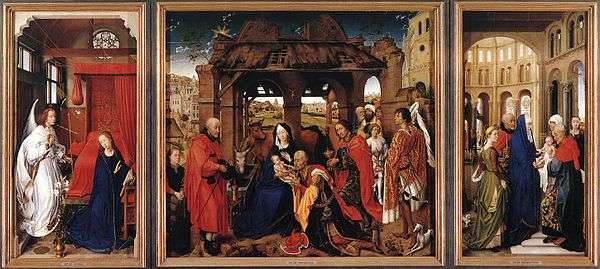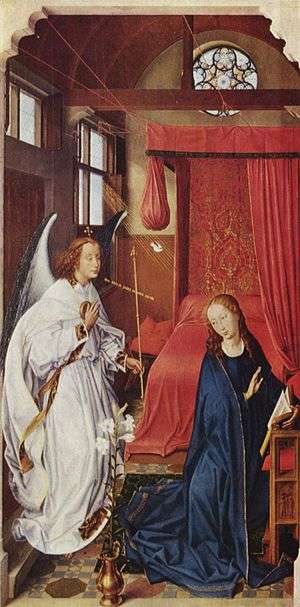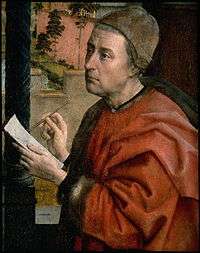Saint Columba Altarpiece
The Saint Columba Altarpiece (sometimes Adoration of the Kings) is a large c. 1455 oil-on-oak wood panel altarpiece by Early Netherlandish painter Rogier van der Weyden, now in the Alte Pinakothek, Munich.[1]

The three panels depict a narrative in which Mary is visited by the archangel Gabriel; she gives birth in a stable, and she presents the infant at the temple. The left wing shows the Annunciation, the center depicts the Adoration of the Magi after Christ's birth, and the Presentation in the Temple appears on the right wing.[1]
Panels

The elegant Annunciation is filled with iconography, such as the faux carving of the fall of man on the side of the prie-dieu at which Mary kneels in her devotions. An old-fashioned cross hangs over her head in the center panel's Nativity scene; the donor is placed on the far left, and a sweeping landscape can be seen in the background.[1] The center panel's far right contains the exterior of the same building shown in the next scene from the inside, juxtaposing the stable with the temple and thereby causing an innovative yet jarring spatial and temporal juxtaposition. The stable is in Bethlehem, the Temple in Jerusalem, yet here they co-exist and function to bridge a gap from the Old to the New Testament. It the first Early Netherlandish painting where the building's exterior exists on one panel and its interior on the adjacent panel. Van der Weyden achieved an extremely innovative means of moving a narrative in a continuous fashion in this altarpiece. The Presentation occurs in the octagonal building's narthex, surrounded by monumental arches, another bold and innovative use of space and perspective.[2]
The exterior panels on the reverse are covered with plain paint without evidence that they ever contained a donor portrait. The donor is positioned on the far left of the center panel.[1]
Saint Columba altarpiece was the object of frequent copying in the 15th and 16th centuries,[1] and inspired some of Hans Memling's works, among them the Triptych of Jan Floreins.[2]
Commission
The altarpiece was included as part of the 1801 inventory of Cologne's St. Kolumba church, where it resided in the von dem Wasservass family chapel, which was probably established in the 1460s by Goddert von dem Wasservass, burgomaster of Cologne. It is reasonable to assume such a prominent resident of the city commissioned the piece. According to Lorne Campbell, based on the number of known copies, the piece probably never left the private chapel until 1801. Sulpiz and Melchior Boisseree bought it in 1808; their collection was acquired in 1827 for the Alte Pinakothek in Munich.[1]
Citations
- Campbell (1980), 74
- Borchert, 87
| Wikimedia Commons has media related to Category:Adoration of the Magi by Rogier van der Weyden. |
Sources
- Borchert, Till-Holger. "Hans Memling and Rogier van der Weyden". In: J. Chapuis (ed), Invention: Northern Renaissance Studies in honor of Molly Faries. Turnhout: Brepols, 2008. ISBN 978-2-503-52768-0
- Campbell, Lorne. Van der Weyden. New York: Harper and Row, 1980. ISBN 0-06-430650-X
